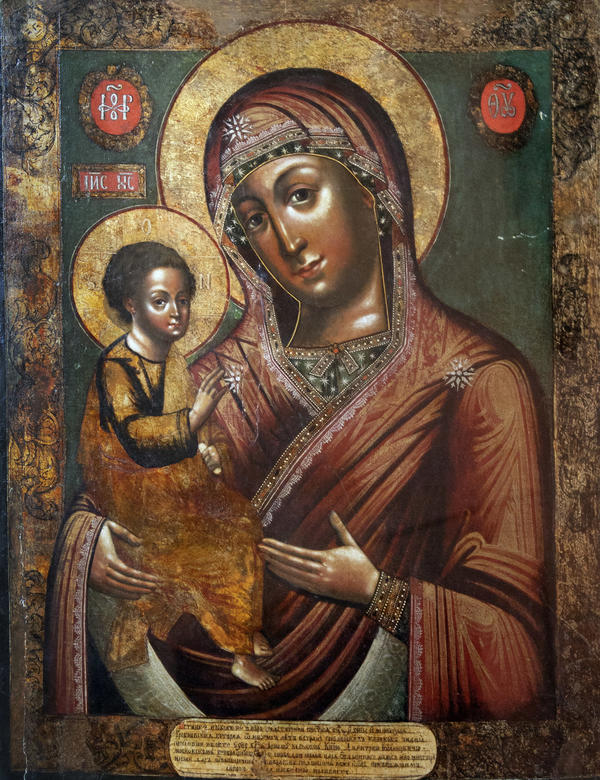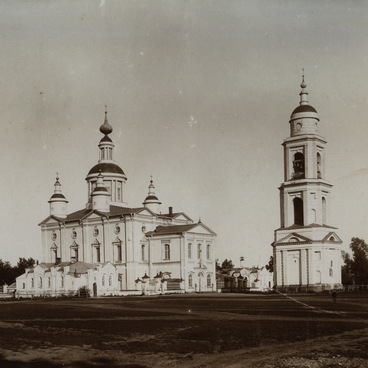The Icon of the Mother of God of Greben from the collection of the Tambov Regional Ethnography Museum is not the original but a replica — a copy. Its author is unknown, but it was possible to find out that the copy was painted in the late 18th — early 19th century. The icon was registered in the book of arrivals of the museum in 1947, in 1984, restoration artist Irina Kuïmova restored the image.
Where the original miraculous icon of the Mother of God of Greben is today is unknown. Its history can be traced back to the end of the 14th century. Legend has it that this icon was given to Prince Dmitry Donskoy in 1380, when he returned from the Battle of Kulikovo. A century later, Ivan III went to war with Novgorod the Great and won annexing the once independent Republic of Novgorod to the Duchy of Moscow. The Icon of the Mother of God of Greben was with him on his military campaign. Upon his return, the prince built a wooden Assumption Church in Moscow and placed the icon there. The square was called Lubyanskaya Square, where the captured Novgorodians settled. According to the legend, in 1687 the church was completely burned down, but the icon, which was not taken out of the fire, miraculously survived and was found outside the church. The temple was rebuilt into a stone one and survived the big fire of 1737, when almost a quarter of all buildings in the city were burned down.
The miraculous Icon of the Mother of God of Greben was considered to be the oldest of the Cossack icons and remained in its church until the 1930s. After the church was closed and destroyed, all track of the icon was lost. Part of the icon screen went to the Tretyakov Gallery and the Kolomenskoye Museum Reserve, but there is no icon that can be identified with the original Icon of Greben.
The Icon of the Mother of God of Greben belongs to a version of iconographic division called Hodigitria — Our Lady of the Way. In Icons of that type, the Theotokos holds Jesus in one hand while pointing the other to Him as the source of salvation for humankind.
The Icon of Greben and its replicas are unusual in that the Theotokos holds her Son in her right hand instead of her left hand. That type of icon is called Hodigitria Dexyocratusa. The icon of the Tambov Museum shows the Theotokos waist high dressed in a red enveloping robe — a long mantle for women, with only half of the right hand of the Theotokos seen. She is pointing to Jesus with her left hand. The right hand of Infant Christ bent in a gesture of blessing is reaching out to the Virgin Mary, his left hand is holding a scroll. He is wearing a golden-ochre himation, a piece of woolen fabric falling from the right shoulder in a big fold. The Icon of Greben is different from other icons of this type in that the robe opens at the neck of the Theotokos showing the neck of the chiton — the undershirt.
The master boxed the image of the Virgin and the Son in a frame decorated with floral ornaments resembling a Khokhloma pattern in form and color. The corners of the decorative frame are adorned with the heads of the cherubim.
Where the original miraculous icon of the Mother of God of Greben is today is unknown. Its history can be traced back to the end of the 14th century. Legend has it that this icon was given to Prince Dmitry Donskoy in 1380, when he returned from the Battle of Kulikovo. A century later, Ivan III went to war with Novgorod the Great and won annexing the once independent Republic of Novgorod to the Duchy of Moscow. The Icon of the Mother of God of Greben was with him on his military campaign. Upon his return, the prince built a wooden Assumption Church in Moscow and placed the icon there. The square was called Lubyanskaya Square, where the captured Novgorodians settled. According to the legend, in 1687 the church was completely burned down, but the icon, which was not taken out of the fire, miraculously survived and was found outside the church. The temple was rebuilt into a stone one and survived the big fire of 1737, when almost a quarter of all buildings in the city were burned down.
The miraculous Icon of the Mother of God of Greben was considered to be the oldest of the Cossack icons and remained in its church until the 1930s. After the church was closed and destroyed, all track of the icon was lost. Part of the icon screen went to the Tretyakov Gallery and the Kolomenskoye Museum Reserve, but there is no icon that can be identified with the original Icon of Greben.
The Icon of the Mother of God of Greben belongs to a version of iconographic division called Hodigitria — Our Lady of the Way. In Icons of that type, the Theotokos holds Jesus in one hand while pointing the other to Him as the source of salvation for humankind.
The Icon of Greben and its replicas are unusual in that the Theotokos holds her Son in her right hand instead of her left hand. That type of icon is called Hodigitria Dexyocratusa. The icon of the Tambov Museum shows the Theotokos waist high dressed in a red enveloping robe — a long mantle for women, with only half of the right hand of the Theotokos seen. She is pointing to Jesus with her left hand. The right hand of Infant Christ bent in a gesture of blessing is reaching out to the Virgin Mary, his left hand is holding a scroll. He is wearing a golden-ochre himation, a piece of woolen fabric falling from the right shoulder in a big fold. The Icon of Greben is different from other icons of this type in that the robe opens at the neck of the Theotokos showing the neck of the chiton — the undershirt.
The master boxed the image of the Virgin and the Son in a frame decorated with floral ornaments resembling a Khokhloma pattern in form and color. The corners of the decorative frame are adorned with the heads of the cherubim.



